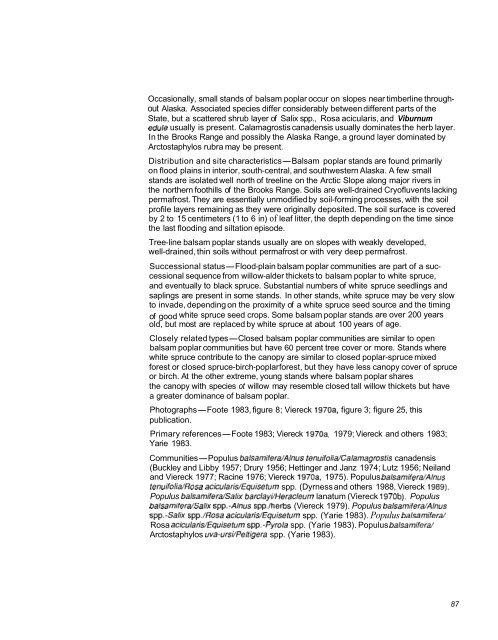The Alaska Vegetation Classification - Alaska Geobotany Center ...
The Alaska Vegetation Classification - Alaska Geobotany Center ...
The Alaska Vegetation Classification - Alaska Geobotany Center ...
Create successful ePaper yourself
Turn your PDF publications into a flip-book with our unique Google optimized e-Paper software.
Occasionally, small stands of balsam poplar occur on slopes near timberline throughout<strong>Alaska</strong>. Associated species differ considerably between different parts of theState, but a scattered shrub layer of Salix spp., Rosa acicularis, and Viburnumedule usually is present. Calamagrostis canadensis usually dominates the herb layer.In the Brooks Range and possibly the <strong>Alaska</strong> Range, a ground layer dominated byArctostaphylos rubra may be present.Distribution and site characteristics-Balsam poplar stands are found primarilyon flood plains in interior, south-central, and southwestern <strong>Alaska</strong>. A few smallstands are isolated well north of treeline on the Arctic Slope along major rivers inthe northern foothills of the Brooks Range. Soils are well-drained Cryofluvents lackingpermafrost. <strong>The</strong>y are essentially unmodified by soil-forming processes, with the soilprofile layers remaining as they were originally deposited. <strong>The</strong> soil surface is coveredby 2 to 15 centimeters (1 to 6 in) of leaf litter, the depth depending on the time sincethe last flooding and siltation episode.Tree-line balsam poplar stands usually are on slopes with weakly developed,well-drained, thin soils without permafrost or with very deep permafrost.Successional status-Flood-plain balsam poplar communities are part of a successionalsequence from willow-alder thickets to balsam poplar to white spruce,and eventually to black spruce. Substantial numbers of white spruce seedlings andsaplings are present in some stands. In other stands, white spruce may be very slowto invade, depending on the proximity of a white spruce seed source and the timingof good white spruce seed crops. Some balsam poplar stands are over 200 yearsold, but most are replaced by white spruce at about 100 years of age.Closely related types-Closed balsam poplar communities are similar to openbalsam poplar communities but have 60 percent tree cover or more. Stands wherewhite spruce contribute to the canopy are similar to closed poplar-spruce mixedforest or closed spruce-birch-poplar forest, but they have less canopy cover of spruceor birch. At the other extreme, young stands where balsam poplar sharesthe canopy with species ot willow may resemble closed tall willow thickets but havea greater dominance of balsam poplar.Photographs-Foote 1983, figure 8; Viereck 1970a, figure 3; figure 25, thispublication.Primary references-Foote 1983; Viereck 1970a, 1979; Viereck and others 1983;Yarie 1983.Communities-Populus balsamifera/Alnus tenuifolia/Calamagrostis canadensis(Buckley and Libby 1957; Drury 1956; Hettinger and Janz 1974; Lutz 1956; Neilandand Viereck 1977; Racine 1976; Viereck 1970a, 1975). Populus balsamifera/Alnustenuifolia/Rosa acicularis/€quisetum spp. (Dyrness and others 1988, Viereck 1989).Populus balsamifera/Salix barclayi/Heracleum lanatum (Viereck 1970b). Populusbalsamifera/Salix spp.-Alnus spp./herbs (Viereck 1979). Populus balsamifera/Alnusspp.-Salix spp./Rosa acicularis/€quiseturn spp. (Yarie 1983). Populus balsamifewRosa acicularis/Equisetum spp.-Pyrola spp. (Yarie 1983). Populus balsamifera/Arctostaphylos uva-ursi/Peltigera spp. (Yarie 1983).87
















